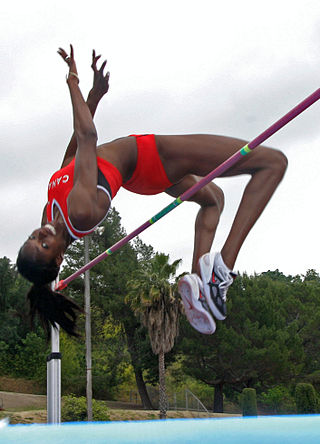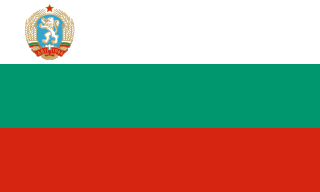Related Research Articles

A gluon is an elementary particle that acts as the exchange particle for the strong force between quarks. It is analogous to the exchange of photons in the electromagnetic force between two charged particles. Gluons bind quarks together, forming hadrons such as protons and neutrons.

The high jump is a track and field event in which competitors must jump unaided over a horizontal bar placed at measured heights without dislodging it. In its modern, most-practiced format, a bar is placed between two standards with a crash mat for landing. Since ancient times, competitors have introduced increasingly effective techniques to arrive at the current form, and the current universally preferred method is the Fosbury Flop, in which athletes run towards the bar and leap head first with their back to the bar.

In physics, spacetime is any mathematical model that fuses the three dimensions of space and the one dimension of time into a single four dimensional continuum. Spacetime diagrams are useful in visualizing and understanding relativistic effects such as how different observers perceive where and when events occur.

An impact event is a collision between astronomical objects causing measurable effects. Impact events have physical consequences and have been found to regularly occur in planetary systems, though the most frequent involve asteroids, comets or meteoroids and have minimal effect. When large objects impact terrestrial planets such as the Earth, there can be significant physical and biospheric consequences, though atmospheres mitigate many surface impacts through atmospheric entry. Impact craters and structures are dominant landforms on many of the Solar System's solid objects and present the strongest empirical evidence for their frequency and scale.

The 1980 Summer Olympics, officially known as the Games of the XXII Olympiad and commonly known as Moscow 1980, were an international multi-sport event held from 19 July to 3 August 1980 in Moscow, Soviet Union, in present-day Russia. The games were the first to be staged in an Eastern Bloc country, as well as the first Olympic Games and only Summer Olympics to be held in a Slavic language-speaking country. They were also the only Summer Olympic Games to be held in a socialist state until the 2008 Summer Olympics held in China. These were the final Olympic Games under the IOC Presidency of Michael Morris, 3rd Baron Killanin before he was succeeded by Juan Antonio Samaranch, a Spaniard, shortly afterwards.
The World Athletics Championships are a biennial athletics competition organized by World Athletics. Alongside the Olympic Games, they represent the highest level championships of senior international outdoor athletics competition for track and field athletics globally, including marathon running and race walking. Separate World Championships are held by World Athletics for certain other outdoor events, including cross-country running and half-marathon, as well as indoor and age-group championships.
A heptathlon is a track and field combined events contest made up of seven events. The name derives from the Greek επτά and ἄθλος. A competitor in a heptathlon is referred to as a heptathlete.

Bulgaria competed at the 1980 Summer Olympics in Moscow, USSR. 271 competitors, 183 men and 88 women, took part in 151 events in 20 sports.

Battelle Hall is a 6,864 seat multi-purpose exhibit hall located in Columbus, Ohio, part of the Greater Columbus Convention Center. It opened as the Ohio Center on September 10, 1980, and although sometimes considered a white elephant because of its small size and seating capacity, it has been used for a variety of events, including concerts, trade shows, and sporting events such as the 1993 and 1994 Mid-American Conference men's basketball tournaments. The exhibit hall was also the home of professional wrestling cards from the early 1980s to mid-1990s with monthly visits from the WWF and the occasional WCW event. The hall totals 90,000 square feet (8,400 m2) of exhibit space - 65,000 on the main floor and 25,000 on the balcony, and can be divisible into two halls.
Marek Franciszek Dopierała is a Polish sprint canoeist who competed during the 1980s. Competing in two Summer Olympics, he won two medals with Marek Łbik at Seoul in 1988 with a silver in the C-2 500 m event and a bronze in the C-2 1000 m event.

Marek Łbik is a Polish sprint canoeist who competed from the late 1970s to the late 1980s. Competing in two Summer Olympics, he won two medals with Marek Dopierała at Seoul in 1988 with a silver in the C-2 500 m event and a bronze in the C-2 1000 m event.
Ulrich Papke is an East German-German sprint canoeist who competed from the early 1980s to the mid-1990s. He won two medals at the 1992 Summer Olympics in Barcelona with a gold in the C-2 1000 m event and a silver in the C-2 500 m event.
The Richter scale, also called the Richter magnitude scale, Richter's magnitude scale, and the Gutenberg–Richter scale, is a measure of the strength of earthquakes, developed by Charles Francis Richter and presented in his landmark 1935 paper, where he called it the "magnitude scale". This was later revised and renamed the local magnitude scale, denoted as ML or ML .
The men's C-2 1000 metres event was an open-style, pairs canoeing event conducted as part of the Canoeing at the 1980 Summer Olympics program.
Lyubomir Lyubenov is a Bulgarian sprint canoeist who competed in the late 1970s and early 1980s. At the 1980 Summer Olympics in Moscow, he won a gold in the C-1 1000 m event and a silver in the C-1 500 m event.
Yuri Lobanov was a Soviet-born Tajikistani sprint canoeist who competed from the early 1970s to the early 1980s. Competing in two Summer Olympics, he won two medals in the C-2 1000 m events with a gold in 1972 and a bronze in 1980. He was affiliated with Tadzhikiston Dushanbe.
Gyula Hajdu is a Hungarian sprint canoer who competed in the early 1980s. He won a gold medal in the C-2 1000 m event at the 1982 ICF Canoe Sprint World Championships in Belgrade and a silver medal in the C-1 500 m event at the 1978 ICF Canoe Sprint World Championships in Belgrade.
The Olympia Gold Classic was a women's professional golf tournament on the LPGA Tour, held in southern California in Los Angeles County from 1978 to 1982. It was played in late winter at the Rancho Park Golf Course in the city of Los Angeles from 1978 to 1980 as the "Sunstar Classic," then moved east to Industry Hills Golf Club in City of Industry in 1981 and 1982, in a renamed event sponsored by Olympia Brewing Company.
Underwater Target Shooting is an underwater sport/shooting sport that tests a competitors’ ability to accurately use a speargun via a set of individual and team events conducted in a swimming pool using freediving or Apnoea technique. The sport was developed in France during the early 1980s and is currently practiced mainly in Europe. It is known as Tir sur cible subaquatique in French and as Tiro al Blanco Subacuático in Spanish.

The Cretaceous–Paleogene (K–Pg) extinction event, also known as the Cretaceous–Tertiary(K–T)extinction, was a sudden mass extinction of three-quarters of the plant and animal species on Earth, approximately 66 million years ago. The event caused the extinction of all non-avian dinosaurs. Most other tetrapods weighing more than 25 kilograms also became extinct, with the exception of some ectothermic species such as sea turtles and crocodilians. It marked the end of the Cretaceous Period, and with it the Mesozoic era, while heralding the beginning of the Cenozoic era, which continues to this day.